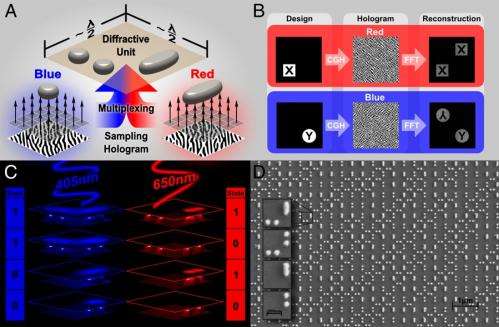August 21, 2014 feature
Color hologram uses plasmonic nanoparticles to store large amounts of information

(Phys.org) —In the 4th century, the Romans built a special glass cup, called the Lycurgus cup, that changes colors depending on which way the light is shining through it. The glass is made of finely ground silver and gold dust that produces a dichroic, or color-changing, effect. Although the makers of the Lycurgus cup likely did not know the mechanism responsible for the color-changing glass, today scientists recognize the mechanism as surface plasmon resonance, and it is a phenomenon that continues to hold great scientific interest.
In a new study published in the Proceedings of the National Academy of Sciences, Yunuen Montelongo, et al., at the University of Cambridge in the UK, have used surface plasmon resonance as a new way to construct holograms. Similar to the Lycurgus cup, the new holograms can change colors due to light scattering off silver nanoparticles of specific sizes and shapes. Due to their ability to simultaneously create two colors and to store large amounts of information, the new holograms could have applications in 3D displays and information storage devices, among others.
"This experiment is inspired by the very unique optical properties shown by the Lycurgus cup," Montelongo told Phys.org. "This exceptional piece changes in color according to the position of the light source. If illuminated from one side it looks green, but if it is illuminated from the other it becomes red. In contrast to other dichroic effects produced by some crystals, such as precious opals, the colorful effects of the Lycurgus cup have little dependence on the position of the observer. In fact, the dichroism found in the Lycurgus cup has a different origin than crystals and so far this 'plasmonic effect' has not been observed in naturally occurring materials."
Although there are several different ways to construct holograms, almost all traditional holograms are single-color, and the multicolor holograms that do exist face limitations. For instance, no methodology exists that can produce multicolor holograms from a surface.
Here, the researchers demonstrated that it is possible to construct multicolor holograms from a single plane. The new holograms consist of precisely engineered silver nanoparticles patterned over a substrate.

A key difference in the new holograms is the smaller size of the diffraction fringes, which control the light wavelength interference. In traditional holograms, these fringes are larger than half the wavelength of light. In contrast, the fringes here are replaced with nanoparticles smaller than half the wavelength of light. The researchers showed that the narrower band diffraction, which creates the colorful effects, is produced by plasmonic-enhanced optical scattering of the nanostructures.
The subwavelength distance offers certain advantages. For instance, two different types of plasmonic nanoparticles can be multiplexed, or combined but not coupled, at subwavelength distances. By using nanoparticles of silver with different shapes and sizes, the researchers could control the colors.
In addition to providing multiple colors, multiplexing two nanoparticles has the advantage of increasing the bandwidth information limits. The researchers showed that each nanoparticle carries independent information, such as polarization and wavelength, which can be controlled simultaneously. With twice the number of nanoparticles, the total amount of binary information stored can exceed the traditional limits of diffraction.
"It has been shown that nanoparticles with resonant properties can be uncoupled over subwavelength distances so their electromagnetic fields have minimal interaction," Montelongo said. "The device presented demonstrates that these nanoparticles can store and transfer independent information beyond the diffraction limits, which is in contrast to nonresonant structures. Because of the nature of this phenomenon, it has been possible to demonstrate, for the first time, a hologram that projects color images in 180 degrees. This projection is so wide that it is not even possible to display it on a plane, and a diffusive sphere should be used."
These features make the new hologram very attractive for future applications.
"Besides the evident application in replacing the typical 'rainbow holograms' of credit cards and other security items, this phenomenon can be used for image projection on spheres, which so far has not been achieved with conventional optics," said coauthor Calum Williams at the University of Cambridge. "Furthermore, this concept can be applied as the basis to produce dynamic three-dimensional color displays. In the area of informatics, these holographic configurations could store information in subwavelength areas. This means that optical data storage devices such as CDs, DVDs or Blu-ray could potentially expand their storage limits."
The researchers plan to further investigate these applications and others in the future.
"Future research is focused on the study of mechanisms for the tuning the plasmonic effect for display applications," Montelongo said. "The main goal is the integration of new modulation schemes to produce ultra-thin displays and dynamic holograms."
More information: Yunuen Montelongo, et al. "Plasmonic nanoparticle scattering for color holograms." PNAS Early Edition. DOI: 10.1073/pnas.1405262111
Journal information: Proceedings of the National Academy of Sciences
© 2014 Phys.org




















